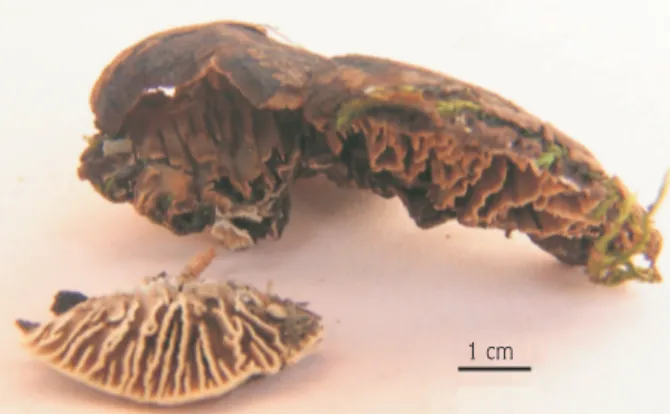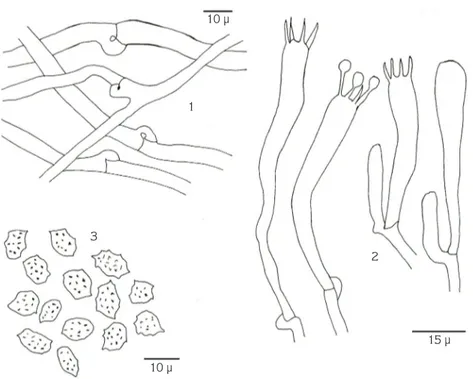Introduction
The genus Lenzitopsis Malençon & Bertault is a monotypic genus and belongs to Thelephoraceae. It is in an isolated position in the family because of perennial, resupinate to reflexed basidiocarps, a monomitic hyphal system, and globose to subglobose spores, which are finely warted and yellow to pale brown in KOH.
First, Malençon & Bertault (1963) described this species from Morocco on Juniperus oxycedrus L. Later Garcia-Manjon & Moreno (1981) reported this species from Guadalajara province in Spain as a saprobe on Juniperus thurifera L. and described it as new for Europe.
Based on the holotype reported by Garcia-Manjon & Moreno (1981) collected on J. thurifera in Spain, Ryvarden (1991) changed the organisation and separated a new monotypic genus with the type species Lenzitella malenconii Ryvarden. However, Ryvarden’s reassignment of names was premature at the least and possibly even outright unnecessary. It was therefore decided to accept the original name Lenzitopsis oxycedrii Malençon & Bertault. Bernicchia (2000) also reported this species from Italy growing as a saprobe on J. oxycedrus. This is a very rare species, known only from a small number of localities in Morocco, Spain, and Italy (Figure 1). Our locality will be the fourth and the host is new for this species.
Turk J Bot 31 (2007) 349-352 © TÜB‹TAK
349
Lenzitopsis oxycedri Malençon & Bertault
(Thelephoraceae, Basidiomycota), a Very Rare Wood-Decay Fungus
Collected in Turkey
Hasan Hüseyin DO⁄AN1,*, Mitko KARADELEV2, Mustafa IfiILO⁄LU3, Celâleddin ÖZTÜRK1 1
Selçuk University, Science & Arts Faculty, Biology Department, 42031 Campus, Konya - TURKEY 2
Institute of Biology, Faculty of Natural Science & Mathematics, Gazi Baba bb., P.O. Box 162, 1000 Skopje, THE REPUBLIC OF MACEDONIA
3
Mu¤la University, Science & Arts Faculty, Biology Department, Kötekli, Mu¤la - TURKEY
Received: 13.02.2007 Accepted: 08.06.2007
Abstract: Lenzitopsis oxycedri Malençon & Bertault was collected on a living branch of Juniperus foetidissima Willd. from Thermessos national park, Antalya, situated in the southern Mediterranean part of Turkey. This very rare species belongs to a monotypic genus of Thelephoraceae and was previously only known from Morocco, Spain, and Italy. This fungus causes white rot in juniper wood.
Key Words:Basidiomycota, Juniperus foetidissima, Lenzitopsis oxycedri, Turkey, wood-decay fungus
Lenzitopsis oxycedri (Thelephoraceae, Basidiomycota), Türkiye’de A¤aç Çürüklü¤üne Neden Olan Çok Nadir Bir Mantar Topland›
Özet: Türkiye’nin Güney Akdeniz bölgesinde bulunan Antalya-Termessos Milli park’›nda Juniperus foetidissima Willd. n›n canl› dal› üzerinde Lenzitopsis oxycedri Malençon & Bertault topland›. Bu çok nadir tür Thelephoraceae’nin monotipik bir cinsidir ve daha önce yaln›zca Fas, ‹spanya ve ‹talya’dan bilinmektedir. Bu mantar ard›ç odununda beyaz çürüklük yapar.
Anahtar Sözcükler:Basidiomycota, Juniperus foetidissima, Lenzitopsis oxycedri, Türkiye, odun-çürüklük mantar›
Research Note
Materials and Methods
The material was collected during the bilateral project between the Institute of Biology within the Faculty of Natural Science & Mathematics in Skopje, Republic of Macedonia, and the Biology Department within the Science & Arts Faculty, Selçuk University, Konya, Turkey, between 2002 and 2005.
The material was examined with Melzer reagent and KOH 5%. Identification was performed by referring to Ryvarden (1993) and Bernicchia (2000, 2005). All material is stored at the Mushroom Application and Research Centre of Selçuk University in Turkey.
Results
Lenzitopsis oxycedri Malençon & Bertault, Bull. Soc. Mycol. Fr. 79: 82 (1963)
Syn: Lenzitella malenconii Ryvarden, Syn. Fung. (Oslo) 5: 174 (1991)
Basidiocarp is perennial, effuse reflexed to pileate, up to 1 cm wide and 2 to 3 cm long, 2-8 mm thick (Figure 2), pliable, when dry often loosening along the margin and orbicular to subpendent, upper surface dark brown
and finely tomentose, later becoming glabrous and almost black; hymenophore semilamellate, sinuous to raduloid or hydnoid with flat teeth, approximately 0.5 to 1 mm between the lamellae or spines, at first whitish, then ochraceous to pale brown (because of the deposited spores) and finely cracked (lens); trama whitish to tan; context or subiculum concolorous and with a black zone towards the substrate or the pileus.
Lenzitopsis oxycedri Malençon & Bertault (Thelephoraceae, Basidiomycota), a Very Rare Wood-Decay Fungus Collected in Turkey
350
Figure 1. Known distribution of L. oxycedri.
1 cm
Hyphal system is monomitic, generative hyphae with clamps, hyaline in trama and context, pale brown in the tomentum, 3-4 µ wide, sparingly branched, when aged with scattered to more or less abundant brownish crystals that become bluish green in KOH (thelephoric acid). Cystidia are absent. Basidia are with 4-stergimata, at first clavate but elongating considerably to sinuous tube-like organs 35-80 µ, with a basal clamp. Basidiospores are globose to subglobose, pale brown, finely warted, often with small inner crystals of pigment, negative in Melzer’s reagent, 6-7(8) ×5-6(7) µ (Figure 3).
Material examined: Thermessos national park, Antalya, on Juniperus foetidissima, 1400 m, 16.03.2003, Do¤an 1250 and 1256.
The material was collected on a living branch of J. foetidissima. The forest mainly consists of mixed Quercus coccifera L. and Phillyrea media L., but in some places J. foetidissima is a form of pure forest, and small J. excelsa stands can be found in the J. foetidissima community.
L. oxycedri causes white rot in Juniper spp. It has unknown cultural characteristics and sexuality (Ryvarden & Gilbertson, 1993; Bernicciha 2000, 2005).
According to the present literature, this is a very rare species, known only from one locality in Morocco and one in Guadalajara province in Spain. It is apparently restricted to Juniperus and known from J. oxycedrus and J. thurifera (Garcia-Manjon & Moreno, 1981). In addition, Bernicchia (2000, 2005) reported this species from Italy growing as a saprobe on J. oxycedrus. In Turkey it was collected twice in Thermessos national park, Antalya, on a branch of J. foetidissima, which is a new host for this species.
Acknowledgements
The research was financially supported by The Scientific and Technological Research Council of Turkey and the Macedonian Ministry of Science and Education (TÜB‹TAK TOGTAG MKD 2002/1).
H. H. DO⁄AN, M. KARADELEV, M. IfiILO⁄LU, C. ÖZTÜRK
351 1 2 3 10 µ 10 µ 15 µ
Figure 3. Microscopic elements of L. oxycedri (from HD1250):
1. Tramal generative hyphae. 2. Basidia. 3. Basidiospores (drawing of specimen by Katerina Aleksovska).
Lenzitopsis oxycedri Malençon & Bertault (Thelephoraceae, Basidiomycota), a Very Rare Wood-Decay Fungus Collected in Turkey
352
References
Bernicchia A (2000). Wood-inhabiting aphyllophoraceous fungi on Juniperus spp. in Italy. Mycotaxon 75: 241-256.
Bernicchia A (2005). Fungi Europaei, Polyporaceae Vol 10. Italy: Edizioni Candusso.
Garcia-Manjon JL & Moreno G (1981). Estudios sobre Aphyllophorales I. Fructificationes sobre Juniperus. An Jard Bot Madrid 37: 407-416.
Malençon G & Bertault R (1963). Lenzitopsis oxycedri Malençon et Bertault, genre nouveau et espéce nouvelle d'aphyllophorale a spores colorees. Bull Soc Mycol France 79: 75-82.
Ryvarden L (1991). Genera of Polypores. Synopsis fungorum 5. pp.174. Oslo, Norway: Fungiflora.
Ryvarden L & Gilbertson RL (1993). European Polypores. Synopsis fungorum 6. Oslo, Norway: Fungiflora.

